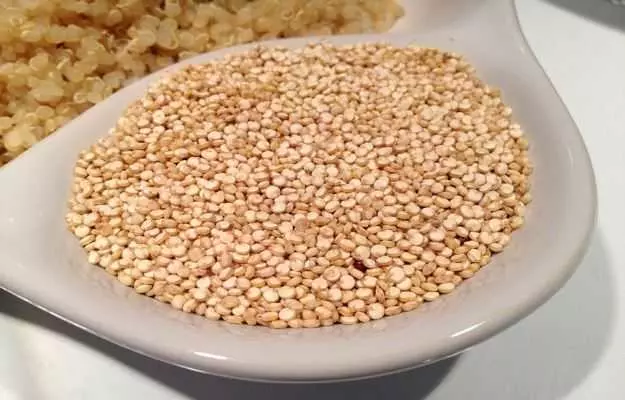Often used as a gluten-free grain, quinoa is actually a seed that was first grown in Peru and Bolivia between 5000 BC and 3000 BC. (By comparison, rice was probably first grown between 7000 and 5000 BC.)
Quinoa belongs to a group of crops known as pseudocereals (along with chia seeds and buckwheat or kuttu). These pseudocereals not only taste like grains, but they are also good sources of energy (additionally, they tend to be cheap in places where they are grown locally).
Over the last few decades, quinoa has gained in popularity as a vegetarian protein source that is also rich in fibre, four out of eight B vitamins (folate, thiamine, riboflavin and pyridoxine) and minerals like manganese, magnesium, iron, phosphorus, copper, zinc and potassium.
Quinoa is quite filling and mild to taste. As such, it can easily replace rice in a pulao or a meal combo with daal or rajma (kidney beans). It can be used in poha, as a replacement for flattened rice. Or in a salad. In the last few years, quinoa biscuits, chips and beer have also been added to supermarket shelves in India.
Some basic facts about quinoa:
Botanical name: Chenopodium quinoa Willd.
Family: Amaranthaceae
Common names: Quinoa
Parts used: Seeds. The bitter saponins at the end of seeds are usually removed during milling—they are thought to have medicinal value.
Native region and geographical distribution: Originally grown in South America, quinoa is a sturdy plant that can withstand drought and frost. As such, it is grown in different parts of India from Uttarakhand to Rajasthan and Andhra Pradesh.
| Nutrients in 100 grams of uncooked quinoa | Quantity |
|---|---|
| Carbohydrates | 64.16 g |
| Proteins | 14.12 g |
| Fats | 6.07 g |
| Dietary fibre | 7 g |
| Water | 13.28 g |
| Calcium | 47 mg |
| Magnesium | 197 mg |
| Potassium | 563 mg |
| Phosphorus | 457 mg |
| Sodium | 5 mg |
| Iron | 4.57 mg |
| Manganese | 2.03 mg |
| Zinc | 3.1 mg |
| Copper | 0.59 mg |
| Choline | 70.2 mg |
| Folate (vitamin B9) | 184 micrograms |
| Vitamin E (alpha-tocopherol) | 2.4 mg |
Source: US Department of Agriculture FoodData Central
Uncooked quinoa has 368 kilocalories in 100 grams.





















